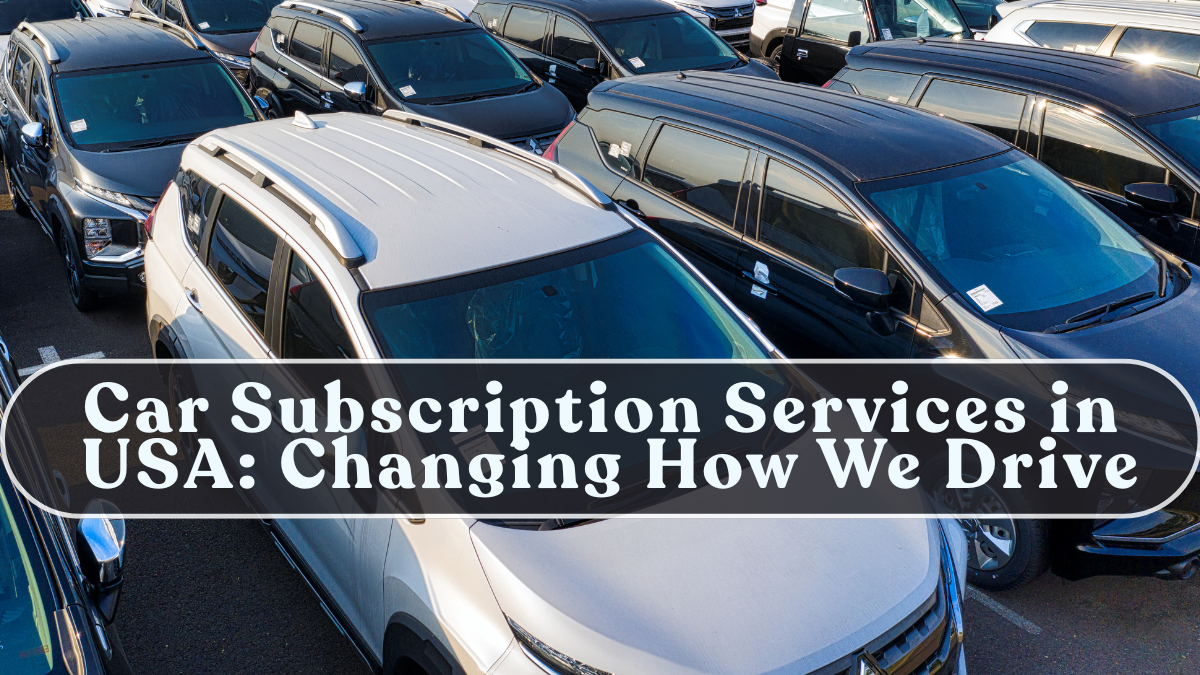Car ownership in the USA is undergoing a revolution. As living costs rise and flexibility becomes a priority, car subscription services have emerged as the next big thing in the mobility market. Instead of buying or leasing, Americans can now subscribe to a vehicle, drive it for a few months, and switch models whenever they like — all for a single monthly payment.

What Are Car Subscription Services?
Car subscriptions are designed for users who want the convenience of having a car without long-term commitments. Subscribers pay a monthly fee that typically covers insurance, maintenance, roadside assistance, and taxes. Once subscribed, users can drive the car as their own — and even swap it out for another vehicle when they need a change.
For instance, a driver could use an SUV for a family trip in summer and switch to a compact EV during winter. It’s flexibility over ownership, and the trend is rapidly expanding across the U.S.
Leading Car Subscription Providers in the USA
Several automakers and startups are capitalizing on the growing auto subscription model trend:
| Service Provider | Key Highlights | Subscription Cost (USD/month) | Vehicle Options |
|---|---|---|---|
| Care by Volvo | Insurance & maintenance included | 700–900 | XC40, XC60, S60 |
| Porsche Drive | Short-term luxury rentals | 2,000–3,000 | Cayenne, 911, Macan |
| Hyundai Evolve+ | Affordable EV subscription | 600–700 | Kona Electric, Ioniq 5 |
| SIXT+ | Flexible duration (1–12 months) | 500–1,000 | Sedans, SUVs |
| Autonomy | EV-only plans | 450–1,000 | Tesla, Polestar, Rivian |
With more providers joining the space, car subscriptions are now available in over 40 states, covering both premium and affordable segments.
Why Americans Are Embracing Car Subscriptions
Changing lifestyles and financial habits are reshaping the U.S. automotive landscape. Millennials and Gen Z consumers prefer flexibility over long-term debt.
Key reasons for rising adoption include:
-
No credit score dependency: Easier access compared to loans or leases.
-
Hassle-free ownership: Insurance, servicing, and paperwork handled by the provider.
-
Flexible tenure: Monthly or quarterly plans without multi-year lock-ins.
-
Eco-conscious behavior: Frequent upgrades allow users to shift to cleaner, newer models.
With urban residents increasingly skipping car ownership, subscription models are filling the gap between renting and buying.
Technology Behind the Subscription Revolution
The success of this model depends heavily on digital platforms and AI-driven fleet management. Most providers operate through mobile apps that let users browse models, sign contracts, and schedule delivery — all online.
-
AI algorithms manage fleet usage and predict demand trends.
-
Telematics ensure real-time tracking, vehicle health monitoring, and safety compliance.
-
Data analytics help companies tailor offers to user preferences and driving habits.
In short, the entire experience is designed to be as seamless as ordering a ride-share but with the perks of full-time car access.
Challenges in the Subscription Ecosystem
Despite its growing popularity, the car subscription industry faces challenges before it can fully rival traditional ownership.
-
Cost factor: Monthly subscriptions can be more expensive in the long run compared to financing.
-
Availability: Limited model options in smaller states or cities.
-
Regulations: Insurance and taxation policies vary widely across jurisdictions.
-
Market awareness: Many consumers are still unaware that car subscriptions exist.
As infrastructure and policies evolve, these obstacles are gradually being overcome through partnerships between automakers and mobility startups.
The Future of Car Subscriptions in the USA
Analysts forecast that car subscriptions could account for 10–15% of urban car usage by 2030. Automakers like Toyota, GM, and BMW are testing their own flexible ownership programs, while EV-only subscriptions are rapidly growing.
Experts believe that the U.S. is heading toward a “mobility-as-a-service” (MaaS) future, where people access vehicles through digital ecosystems rather than owning them outright. This model aligns perfectly with the global push for sustainability and efficient urban transportation.
Conclusion
The car subscription trend in the USA is reshaping the very idea of vehicle ownership. It blends convenience, flexibility, and sustainability into one user-friendly package. For today’s urban professionals, it represents freedom without financial burden. As automakers continue to innovate, the future of driving in America may not depend on what you own — but on what you choose to subscribe to.
FAQs
How do car subscription services differ from car leases?
Subscriptions include insurance, maintenance, and the option to swap vehicles — unlike leases, which lock you into one car for years.
Are car subscriptions cheaper than buying?
Short-term, yes; but over several years, owning or leasing may still be cheaper depending on usage.
Can I cancel a subscription anytime?
Most providers allow cancellation after a minimum term (typically 1–3 months) without heavy penalties.
Which is the most popular car subscription in the USA?
Care by Volvo and Hyundai Evolve+ lead the U.S. market in terms of flexibility and reliability.
Are electric cars available through subscriptions?
Yes, several providers like Autonomy and Hyundai Evolve+ specialize in EV-only subscriptions.
